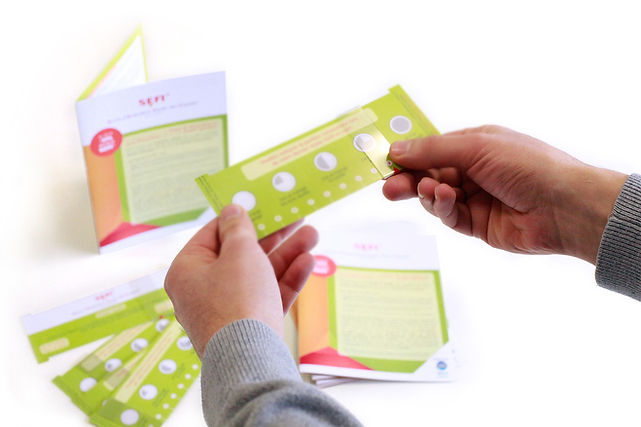Interpret the results

The interpretation of the results of the SEFI® is based on the results of five clinical studies.
-
In 114 in- and out- adult patients either malnourished or at risk of malnutrition, a strong correlation was found between the score of the visual analogue scale and the daily energy intakes assessed by the 3-day dietary record.(3) Moreover, 81% of those with scores <7 were at risk of malnutrition according to the Nutritional Risk Index (NRI).(18) These results were confirmed by an independent study conducted in 1762 medical oncology patients.(4)
SEFI® allows identifying the risk of malnutrition if visual analogue scale score <7.
-
The European multicenter survey Nutrition Day in 16,290(1) then 103,920 adult hospitalized patients worldwide established that food consumption ≤50% of offered portions at lunch or dinner was associated with an increased risk (by a factor of 2 to 8) of death 30 days after the evaluation.
In adults, SEFI® can identify a risk of malnutrition if the consumed portion is ≤1/2 of the plate.
-
In a cohort of patients newly diagnosed with idiopathic pulmonary fibrosis, insufficient food intake, defined by a SEFI® score of <7 at diagnosis, was associated with increased mortality and more hospitalizations within one year.(10) Among hospitalized malnourished patients, a SEFI® score of <7 was linked to a higher risk of hospital readmission within 30 days(11) In multivariate analysis, each additional SEFI® point was associated with either a reduction in the risks of hospitalization and death(10) or a decreased risk of hospital readmission within 30 days.(11)
SEFI® allows the detection of the risk of malnutrition if the consumed portion is ≤1/2 of the meal main course.
-
Two studies reveal that SEFI® is effective in detecting malnutrition among residents in nursing homes : In 93 patients residing in nursing homes, the sensitivity, specificity, and positive and negative predictive values for the diagnosis of malnutrition, defined by a Mini nutritional assessment (MNA)® <17, of consumption ≤1/2 of a plate (assessed by a caregiver) were 75%, 87%, 67% and 91%, respectively (AUC=0,81).(7) In 70 nursing home residents, the stability of SEFI® in the month following the evaluation suggests a monthly food intake monitoring rhythm. SEFI® <7 correctly predicts (AUC=0,71) the diagnosis of malnutrition according to GLIM criteria,(12) with sensitivity, specificity, positive and negative predictive values of 56%, 65%, 58%, and 63%, respectively.(8)
In nursing homes, SEFI® diagnoses malnutrition if the consumed portion is ≤1/2 of the meal main course.
-
In 505 patients consulting their GP in the community setting, the sensitivity, specificity, positive and negative predictive values of SEFI® visual analogue scale <7 to diagnose malnutrition defined as weight loss ≥10% in 6 month and/or ≥5% in 1 month and/or BMI ≤18.5 (or <21 if age ≥70 yr), were respectively: 34, 85, 13, and 96%.(5)
In the community setting, SEFI® is accurate to rule out the diagnosis of malnutrition, if score ≥7.
1. Hiesmayr M, et al. Decreased food intake is a risk factor for mortality in hospitalised patients: The Nutrition Day survey 2006. Clin Nutr 2009;28:484-491.
3. Thibault R, et al. Use of 10-point analogue scales to estimate dietary intake: A prospective study in patients nutritionally at-risk. Clin Nutr 2009;28:134-140.
4. Guerdoux-Ninot et al. Assessing dietary intake in accordance with guidelines: Useful correlations with an ingesta- Verbal/Visual Analogue Scale in medical oncology patients. Clin Nutr 2018, Jun 30. pii: S0261-5614(18)31193-2. doi: 10.1016/j.clnu.2018.06.974.
5. Bouëtté G, et al. A visual analogue scale for food intake as a screening test for malnutrition in the primary care setting: Prospective non-interventional study. Clin Nutr 2021;40:174-180.
10. Jouneau S, et al. Malnutrition and decreased food intake at diagnosis are associated with hospitalization and mortality of idiopathic pulmonary fibrosis patients. Clin Nutr 2022;41:1335-1342.
11. Rageul E et al. Une prise alimentaire insuffisante à l’hôpital est associée à un risque plus élevé de réadmission hospitalière chez des patients pris en charge par l’Unité Transversale de Nutrition (UTN) d’un centre hospitalier universitaire (CHU). Communication orale. Journées Francophones de Nutrition 2022.
12. Cederholm T, et al. GLIM criteria for the diagnosis of malnutrition: a consensus report from the global clinical nutrition community. Clin Nutr 2019;38:1-9
13. Delarue J, et al. Diagnosing undernutrition children and adults: new French criteria. Why, for what and for whom? A joint statement of the French National Authority for Health and French Federation of Nutrition. Br J Nutr 2022;127:739-751.
18. Buzby GP, et al. A randomised clinical trial of total parenteral nutrition in malnourished surgical patients: the rationale and impact of previous clinical trials and pilot study on protocol design. Am J Clin Nutr 1988;47 (Suppl. 2):357-365.